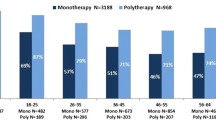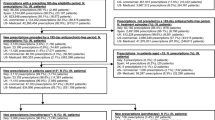Abstract
This study assessed whether the addition of adjunctive psychotherapy to antipsychotic pharmacotherapy improved antipsychotic persistence and reduced the risk of hospitalization among patients with schizophrenia using 2001–2003 Medicaid claims data from four states: Illinois, Kansas, Minnesota, and North Carolina. New antipsychotic users aged 18 or older were included. Our study showed that adjunctive psychotherapy use was associated with increased antipsychotic persistence during the first two months of treatment but was not associated with risk of hospitalization. Further research is needed to understand how to optimize the benefits of psychotherapy in terms of frequency of appointments, duration, and type.


Similar content being viewed by others
References
American Psychiatric Association. (2000). Diagnostic and statistical manual of mental disorders: DSM-IV-TR. http://www.psychiatryonline.com.libproxy.lib.unc.edu/resourceTOC.aspx?resourceID=1. Accessed 3 March 2010.
American Psychiatric Association. (2004). Treating schizophrenia: A quick reference guide. American Psychiatric Association practice guidelines for the treatment of psychiatric disorders 2004.
Anderson, K. H., Ford, S., Robson, D., Cassis, J., Rodrigues, C., & Gray, R. (2010). An exploratory, randomized controlled trial of adherence therapy for people with schizophrenia. International Journal of Mental Health Nursing, 19(5), 340–349. doi:10.1111/j.1447-0349.2010.00681.x.
Berndt, E. R. (2004). Changes in the costs of treating mental health disorders: An overview of recent research findings. Pharmacoeconomics, 22(2 Suppl 2), 37–50.
Boczkowski, J. A., Zeichner, A., & DeSanto, N. (1985). Neuroleptic compliance among chronic schizophrenic outpatients: an intervention outcome report. Journal of Consulting and Clinical Psychology, 53(5), 666–671.
Bollini, P., Pampallona, S., Nieddu, S., Bianco, M., Tibaldi, G., & Munizza, C. (2008). Indicators of conformance with guidelines of schizophrenia treatment in mental health services. Psychiatric Services, 59(7), 782–791. doi:10.1176/appi.ps.59.7.782.
Brookhart, M. A., Wang, P. S., Solomon, D. H., & Schneeweiss, S. (2006). Evaluating short-term drug effects using a physician-specific prescribing preference as an instrumental variable. Epidemiology, 17(3), 268–275. doi:10.1097/01.ede.0000193606.58671.c500001648-200605000-00011.
Brookhart, M. A., Rassen, J. A., Wang, P. S., Dormuth, C., Mogun, H., & Schneeweiss, S. (2007). Evaluating the validity of an instrumental variable study of neuroleptics: Can between-physician differences in prescribing patterns be used to estimate treatment effects? Med Care, 45(10 Supl 2), S116–S122. doi:10.1097/MLR.0b013e318070c05700005650-200710002-00020.
Bustillo, J., Lauriello, J., Horan, W., & Keith, S. (2001). The psychosocial treatment of schizophrenia: An update. American Journal of Psychiatry, 158(2), 163–175.
Charlson, M. E., Pompei, P., Ales, K. L., & MacKenzie, C. R. (1987). A new method of classifying prognostic comorbidity in longitudinal studies: development and validation. Journal of Chronic Diseases, 40(5), 373–383.
Deyo, R. A., Cherkin, D. C., & Ciol, M. A. (1992). Adapting a clinical comorbidity index for use with ICD-9-CM administrative databases. Journal of Clinical Epidemiology, 45(6), 613–619. doi:10.1016/0895-4356(92)90133-8.
Dixon, L., Lyles, A., Smith, C., Hoch, J. S., Fahey, M., Postrado, L., et al. (2001). Use and costs of ambulatory care services among Medicare enrollees with schizophrenia. Psychiatric Services, 52(6), 786–792.
Dolder, C. R., Lacro, J. P., Dunn, L. B., & Jeste, D. V. (2002). Antipsychotic medication adherence: is there a difference between typical and atypical agents? American Journal of Psychiatry, 159(1), 103–108.
Eaddy, M., Grogg, A., & Locklear, J. (2005). Assessment of compliance with antipsychotic treatment and resource utilization in a Medicaid population. Clinical Therapeutics, 27(2), 263–272.
Greene, W. H. (2007). Econometric analysis (6th ed.). New Jersey: Prentice Hall.
Guo, X., Zhai, J., Liu, Z., Fang, M., Wang, B., Wang, C., et al. (2010). Effect of antipsychotic medication alone vs combined with psychosocial intervention on outcomes of early-stage schizophrenia: A randomized, 1-year study. Archives of General Psychiatry, 67(9), 895–904. doi:10.1001/archgenpsychiatry.2010.105.
Haro, J. M., Kontodimas, S., Negrin, M. A., Ratcliffe, M., Suarez, D., & Windmeijer, F. (2006). Methodological aspects in the assessment of treatment effects in observational health outcomes studies. Applied Health Economics and Health Policy, 5(1), 11–25.
Hudson, T. J., Owen, R. R., Thrush, C. R., Armitage, T. L., & Thapa, P. (2008). Guideline implementation and patient-tailoring strategies to improve medication adherence for schizophrenia. Journal of Clinical Psychiatry, 69(1), 74–80.
Klungel, O. H., Martens, E. P., Psaty, B. M., Grobbee, D. E., Sullivan, S. D., Stricker, B. H., et al. (2004). Methods to assess intended effects of drug treatment in observational studies are reviewed. Journal of Clinical Epidemiology, 57(12), 1223–1231. doi:10.1016/j.jclinepi.2004.03.011.
Leff, J., Berkowitz, R., Shavit, N., Strachan, A., Glass, I., & Vaughn, C. (1990). A trial of family therapy versus a relatives’ group for schizophrenia. Two-year follow-up. British Journal of Psychiatry, 157, 571–577.
Lehman, A. F., & Steinwachs, D. M. (1998). Translating research into practice: The Schizophrenia Patient Outcomes Research Team (PORT) treatment recommendations. Schizophrenia Bulletin, 24(1), 1–10.
Lehman, A. F., Kreyenbuhl, J., Buchanan, R. W., Dickerson, F. B., Dixon, L. B., Goldberg, R., et al. (2004a). The Schizophrenia Patient Outcomes Research Team (PORT): Updated treatment recommendations 2003. Schizophrenia Bulletin, 30(2), 193–217.
Lehman, A. F., Lieberman, J. A., Dixon, L. B., McGlashan, T. H., Miller, A. L., Perkins, D. O., et al. (2004b). Practice guideline for the treatment of patients with schizophrenia, second edition. American Journal of Psychiatry, 161(2 Suppl), 1–56.
McEvoy, J. P., Scheifler, P. L., & Frances, A. (1999). Treatment of schizophrenia 1999. The expert consensus guideline series. Journal of Clinical Psychiatry, 60(Suppl 11), 3–80.
Mojtabai, R., & Olfson, M. (2008). National trends in psychotherapy by office-based psychiatrists. Archives of General Psychiatry, 65(8), 962–970. doi:10.1001/archpsyc.65.8.962.
Mojtabai, R., Nicholson, R. A., & Carpenter, B. N. (1998). Role of psychosocial treatments in management of schizophrenia: A meta-analytic review of controlled outcome studies. Schizophrenia Bulletin, 24(4), 569–587.
Munk-Jorgensen, P., Mortensen, P. B., & Machon, R. A. (1991). Hospitalization patterns in schizophrenia. A 13-year follow-up. Schizophrenia Research, 4(1), 1–9.
Newhouse, J. P., & McClellan, M. (1998). Econometrics in outcomes research: The use of instrumental variables. Annual Review of Public Health, 19, 17–34. doi:10.1146/annurev.publhealth.19.1.17.
Olfson, M., & Marcus, S.C. (2010). National trends in outpatient psychotherapy. Journal of the American Psychiatric. doi:10.1176/appi.ajp.2010.10040570.
Olfson, M., Marcus, S. C., & Wan, G. J. (2009). Treatment patterns for schizoaffective disorder and schizophrenia among Medicaid patients. Psychiatric Services, 60(2), 210–216. doi:10.1176/appi.ps.60.2.210.
Patterson, T. L., & Leeuwenkamp, O. R. (2008). Adjunctive psychosocial therapies for the treatment of schizophrenia. Schizophrenia Research, 100(1–3), 108–119. doi:10.1016/j.schres.2007.12.468.
Penn, D. L., & Mueser, K. T. (1996). Research update on the psychosocial treatment of schizophrenia. American Journal of Psychiatry, 153(5), 607–617.
Penn, D. L., Mueser, K. T., Tarrier, N., Gloege, A., Cather, C., Serrano, D., et al. (2004). Supportive therapy for schizophrenia: possible mechanisms and implications for adjunctive psychosocial treatments. Schizophrenia Bulletin, 30(1), 101–112.
Pfammatter, M., Junghan, U. M., & Brenner, H. D. (2006). Efficacy of psychological therapy in schizophrenia: conclusions from meta-analyses. Schizophrenia Bulletin, 32(Suppl 1), S64–S80. doi:10.1093/schbul/sbl030.
Quan, H., Sundararajan, V., Halfon, P., Fong, A., Burnand, B., Luthi, J. C., et al. (2005). Coding algorithms for defining comorbidities in ICD-9-CM and ICD-10 administrative data. Medical Care, 43(11), 1130–1139. doi:http://www.ncbi.nlm.nih.gov/pubmed/16224307.
Ray, W. A. (2003). Evaluating medication effects outside of clinical trials: New-user designs. American Journal of Epidemiology, 158(9), 915–920.
Rector, N. A., & Beck, A. T. (2002). A clinical review of cognitive therapy for schizophrenia. Current Psychiatry Reports, 4(4), 284–292.
Research Data Assistance Center. (2008). Brief descriptions of SMRF and MAX files. http://www.resdac.umn.edu/Medicaid/file_descriptions.asp. Accessed 29 Jan 2009.
Svarstad, B. L., Shireman, T. I., & Sweeney, J. K. (2001). Using drug claims data to assess the relationship of medication adherence with hospitalization and costs. Psychiatric Services, 52(6), 805–811.
Turkington, D., Dudley, R., Warman, D. M., & Beck, A. T. (2004). Cognitive-behavioral therapy for schizophrenia: A review. International Journal of Psychiatry in Clinical Practice, 10(1), 5–16. doi:10.1097/00131746-200401000-00002.
Velligan, D. I., Weiden, P. J., Sajatovic, M., Scott, J., Carpenter, D., Ross, R., et al. (2009). The expert consensus guideline series: adherence problems in patients with serious and persistent mental illness. Journal of Clinical Psychiatry, 70(Suppl 4), 1–46.
Weiden, P. J., & Olfson, M. (1995). Cost of relapse in schizophrenia. Schizophrenia Bulletin, 21(3), 419–429.
Weiden, P. J., Kozma, C., Grogg, A., & Locklear, J. (2004). Partial compliance and risk of rehospitalization among California Medicaid patients with schizophrenia. Psychiatric Services, 55(8), 886–891. doi:10.1176/appi.ps.55.8.886.
West, J. C., Wilk, J. E., Rae, D. S., Narrow, W. E., & Regier, D. A. (2003). Economic grand rounds: Financial disincentives for the provision of psychotherapy. Psychiatric Services, 54(12), 1582–1583.
West, J. C., Wilk, J. E., Olfson, M., Rae, D. S., Marcus, S., Narrow, W. E., et al. (2005). Patterns and quality of treatment for patients with schizophrenia in routine psychiatric practice. Psychiatric Services, 56(3), 283–291. doi:10.1176/appi.ps.56.3.283.
Wu, E. Q., Birnbaum, H. G., Shi, L., Ball, D. E., Kessler, R. C., Moulis, M., et al. (2005). The economic burden of schizophrenia in the United States in 2002. Journal of Clinical Psychiatry, 66(9), 1122–1129.
Wu, E. Q., Shi, L., Birnbaum, H., Hudson, T., & Kessler, R. (2006). Annual prevalence of diagnosed schizophrenia in the USA: A claims data analysis approach. Psychological Medicine, 36(11), 1535–1540.
Zygmunt, A., Olfson, M., Boyer, C. A., & Mechanic, D. (2002). Interventions to improve medication adherence in schizophrenia. American Journal of Psychiatry, 159(10), 1653–1664.
Conflict of interest
Dr. Rao: stock ownership with Eli Lilly, Inc., and Pfizer, Inc., Dr. Maciejewski was also supported by a Research Career Scientist award from the Department of Veterans Affairs (RCS 10-391). Drs. Maciejewski and Farley have received consulting support from Novartis Pharmaceuticals Corp. over the past 12 months. The remaining authors have no conflict of interests to disclose.
Author information
Authors and Affiliations
Corresponding author
Additional information
Part of the study results has been published as a poster presentation in the 2011 American Pharmacist Association Annual Meeting and Exposition.
Rights and permissions
About this article
Cite this article
Wang, CC., Maciejewski, M.L., Rao, J.K. et al. Examining the Relationship Between Adjunctive Psychotherapy Use and Antipsychotic Persistence and Hospitalization. Adm Policy Ment Health 41, 598–607 (2014). https://doi.org/10.1007/s10488-013-0503-7
Published:
Issue Date:
DOI: https://doi.org/10.1007/s10488-013-0503-7




